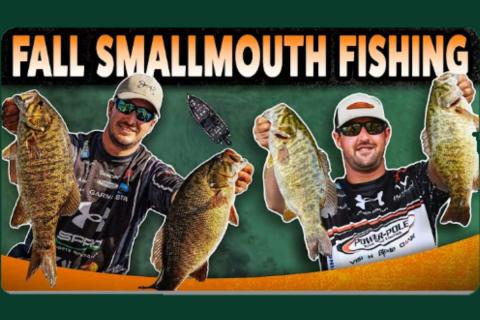
Fall Smallmouth Fishing Tips with Chris & Cory Johnston: Lures and Techniques for Every Stage of the Season
By Chris & Cory Johnston, Bass Pro Shops Pro Staff
When the leaves start to turn and water temperatures begin to drop, smallmouth bass behavior changes dramatically. Chris and Cory Johnston know exactly how to take advantage of it.
From Canadian shield lakes to southern reservoirs
Chris and Cory have spent decades perfecting their fall smallmouth strategy. It is a season of transitions, where fish group up, move shallow, and then back off again as winter approaches. By knowing when to cover water fast with reaction baits and when to slow down with finesse presentations, you can catch numbers of bass and have a shot at your biggest smallmouth of the year.
Why Fall is Prime Time for Smallmouth
In fall, smallmouth group tightly on specific spots and feed heavily before the winter slowdown.
Key Locations
“Up north, we see fish push shallow to island tips, sand flats, and points with isolated cover,” Chris explains. “In reservoirs with shad, smallmouth follow baitfish right to the bank and hit reaction baits hard.” The key is finding something different, such as a lone weed clump, an isolated rock, or a small patch of gravel, that holds bait and draws in the school.
Early Fall (55–65°F) – Transition Stage
Where to Fish
- Offshore rock piles and summer haunts
- Transition zones leading to shallow flats or points
- Sand-to-rock changes near shorelines
Best Techniques
Deep-Diving Crankbaits
Runs 10 to 15 feet, occasionally grinding bottom or ticking just above it.
Burn quickly to trigger reaction strikes from fish tight to bottom.
Bladed Jigs
A 1/2 oz model allows you to cover water fast.
Effective around grass, rock, and mixed cover and often attracts the biggest smallmouth in the system.
Jerkbaits
Excellent for covering water and getting multiple fish to follow and bite.
Mid to Late Fall (45–55°F) – Shallow Grouping and Aggressive Feeding
Where to Fish
- Shallow flats with isolated cover such as weed clumps or boulders
- Points of islands, sand flats close to shore
- Bait-rich banks in shad-driven reservoirs
Best Techniques
Squarebill Crankbaits – Ideal when grass is absent and effective for deflecting off cover to trigger bites.
Finesse Tubes – Work slowly along bottom where fish hold tight. Shake gently in place to tempt neutral bass.
Ned Rigs – Perfect for follow-up after aggressive baits stop producing. Downsized presentation to fool pressured fish.
Drop Shots with Small Swimbaits – Nose-hooked minnow-style plastics maintain action while dragging along bottom.
The Johnston Brothers’ Gear Setup
Line: 10 to 12 lb fluorocarbon for finesse; 15 to 20 lb braid with fluorocarbon leader for reaction baits
Rods: Medium to medium-heavy spinning and casting setups
Reels: High-speed for reaction baits and smooth-drag spinning reels for finesse work
Colors: Natural shad or baitfish for reaction baits; green pumpkin, brown, or goby for bottom presentations
Featured Products
Deep-diving crankbaits (10 to 15 ft range)
Bladed jigs (1/2 oz)
Jerkbaits and squarebill crankbaits
3.5" finesse tubes
Ned rig heads and plastics
Drop shot hooks, weights, and minnow-style baits
Available online and in-store at Bass Pro Shops and Cabela’s.
Final Takeaways from Chris & Cory Johnston
“Fall smallmouth fishing is all about location and timing,” Cory says. “Find where they are grouped, figure out their stage, and adjust your presentation.”
• Cover water fast with reaction baits to find active groups.
• Once located, slow down with finesse presentations to catch the rest.
• Mix up lures. If fish stop biting a tube, switch to a Ned rig or drop shot.
• Leave resting schools and return later to catch more.
Ready to Gear Up?
? Shop Online
Discover a wide selection of outdoor products at Bass Pro Shops and Cabela's.
? Visit a Store Near You
Experience our expert service and see our gear up close by visiting a Bass Pro Shops or Cabela’s location. Find the store nearest you with our Store Locator.
- 969 views

